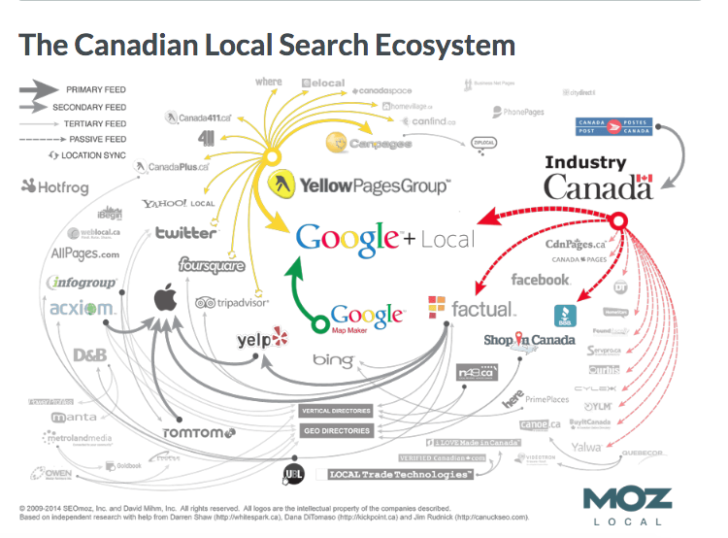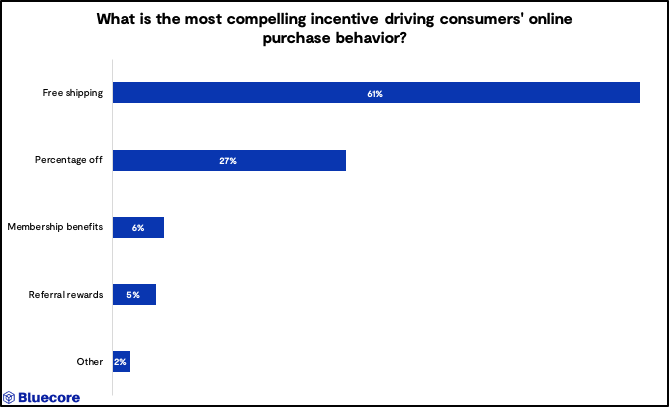Marketing Strategies
Guide: How to structure a local SEO strategy for your business
30-second summary:
- Take advantage of Google’s search market domination with two spots on the first page of Google - Local pack and localized organic search results.
- Optimize for high converting local keywords, establish a local content schedule, and more.
- Founder of Digital Ducats Inc. shares a thorough guide on everything you need for a successful local SEO strategy.
For many companies, an effective SEO strategy for local business is the key factor for increasing revenue from high converting traffic. Local SEO can mean the difference in outranking authority websites for vital keywords within your city.
Along with the overall benefits of SEO, optimizing to compete locally improves your search visibility for keyword searches made from your location.
Many aspects of local SEO have remained the same over the last few years however, the weight of local ranking factors has shifted creating new priorities for local businesses.
One aspect that remains the prime focus for every local business is the significance of Google My Business.
1. Gain instant visibility with GMB
Google My Business has been instrumental in driving customers to a local business. Considering the search engine market share that Google holds, you’re literally losing money by not having a GMB listing.
As of June 2020, Google tops the charts for search engine market share boasting 86% of desktop and 95% of total mobile searches.
It should be clear that failing to prioritize your presence in GMB can cost your company thousands of dollars.
One of the many advantages that Google My Busines allows is instant search visibility for a business operating in a locality. Rather than going through the process of ranking your own domain, your website receives instant search visibility from local searches within close proximity.
The Possum update made proximity a primary ranking factor for achieving a top position in the Local Pack. Your company can appear on the first page of results based on the distance between your location and the location of a user.
In 2020, according to the State Of Local SEO Industry Report, proximity has fallen to the third most influential ranking factor behind on-page optimization and reviews. The general consensus among those surveyed is that optimizing your listing is the top priority for ranking in the Local Pack.
2. Optimize your GMB profile
Optimize your GMB listing just as you would your website in terms of providing as much information to search engines as possible. The more detail you can provide in your profile, the more information search engines have to reference your business for keyword related searches.
NAP details
Fill in every option available to maximize your opportunities to appear in the Local Pack. Name, address, and phone number (NAP details) are extremely important to have spelled correctly.
Obviously, this is important for users to receive the correct information. Search engines will also verify your business details with third party citations.
Explore all category options
One of the biggest mistakes small business owners make is failing to include the correct categories. There has been a countless number of clients that have been able to rank in the Local Pack by simply adding the correct category for their business.
Google updates the list of eligible categories your business can fall under. It’s advisable to check periodically for new categories that would enhance the accuracy of your listing.
One way to explore any options you may have missed is to search Google for the local keywords you’re targeting. Check the Local Finder for the categories that your competition is using to rank in the top positions.
Keyword optimization
It should be noted that on-page optimization is proving to be the strongest ranking factor for ranking in the Local Pack. This can be a source of frustration for those who operate under Google guidelines since Google has allowed keyword stuffing to trump other ranking factors.
If you’re adhering to Google’s guidelines, the name of your business should be the only thing in your GMB listing. What should be happening and what is actually working are two different things that have created somewhat of a loophole and a grey area for SEO.
The fact is that using the keyword in the name of your business will get you results. It’s as simple as that.
If you’re starting a business that operates in a specific city it’s highly effective to incorporate your main keyword in the name of your business. It’s been so effective that it’s led to keyword stuffing-which, in theory, should be penalized-but seems to be left unregulated.
Here is an example of successful keyword manipulation for the phrase “bespoke suits Toronto”. Each of these sites outranks other sites based on the name used in the GMB profile.
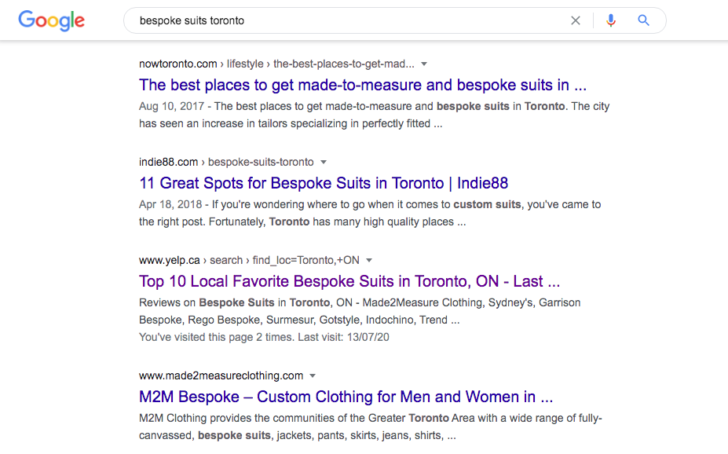
It’s hard to say what will prevail in the long run because the evidence points to the fact that this is working to rank sites. After monitoring this listing for over 6 months, it continues to rank and undoubtedly reaps the benefits of local traffic from a prime placement in the local pack.
3. Build your local presence with citations
Structured citations an essential element in local SEO despite the reduced effectiveness they once had as a ranking factor. Their purpose serves two functions; to validate your business information for search engines; to provide additional targeted traffic.
List your business in well-known directories
List your business in the largest and most relevant directories for your city or region to get the most coverage from relevant citations. Some of the most obvious are Bing and Yahoo since they both have local business listings.
Major directories will typically serve as a source of information for much smaller, but relevant websites. Your business information is essentially distributed to dozens of other directories that will help to establish the validity and credibility of your business.
The major directories from each country and region can vary so it’s important to establish which sites will have the most impact with the least effort.
In Canada, posting your business on Yellow Pages results in a wide distribution of sites that are relevant to Canada. Moz provides an excellent visual as an example of the distribution network Yellow Pages provides.
Source: Moz
Here’s an example of the U.S. local ecosystem provided by Moz (keep in mind these images are now a few years old). According to this illustration below, there are many major directories that can have a large impact on your search visibility in the U.S.
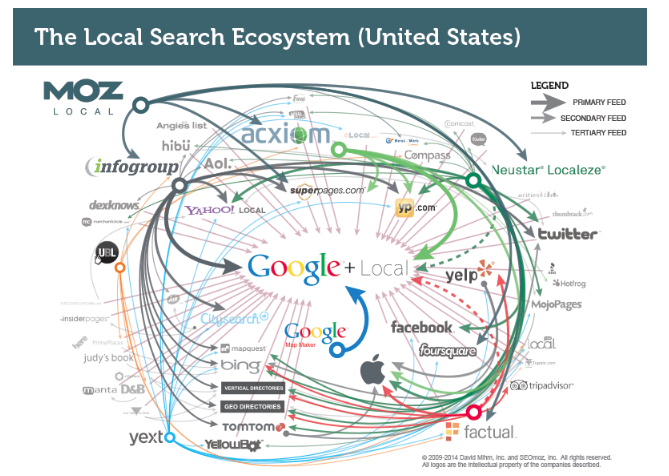
Search for niche and local directories
Enhance the profile of your citations and improve your sources of traffic by searching for directories that are niche-specific and location-specific.
Getting a few links from directories that are in your niche and location will improve the relevance of your site in both areas. Look for relevant directories by using the following in a search:
[Your niche] + directories
[Your location] + directories
Qualify each directory
Make sure the sites you choose to place your business have a decent amount of traffic and authority. Even if a directory is unique in your city, if it has a high spam score (use Mozbar to filter these sites), or has extremely low domain authority it may do more harm than good.
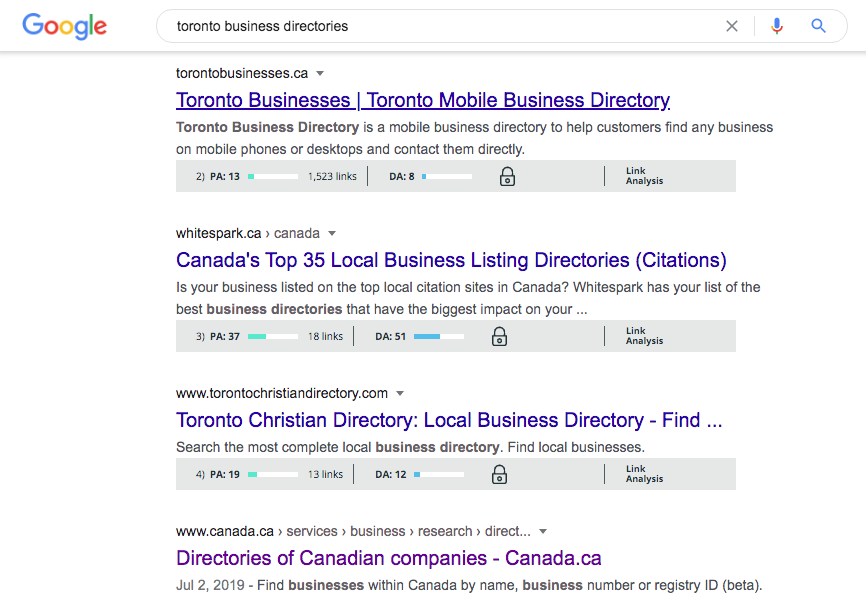
SEMRush is also a good tool to use for a quick reference on the amount of traffic a website receives. If the organic search traffic is a bust, don’t list your company website on it.

You don’t need a lot of these sites to complete an effective citation profile. Google won’t give a whole lot of credit for acquiring easy links. The goal of this endeavor is to create significant ties to your city and industry and position your company on sites that get relevant traffic.
4. Establish your content strategy
Your website is only as good as the content you publish. Create content to serve as a resource for clients. Educational content produces three times as many leads as paid ads. Keep in mind you will need to publish both educational content as well as local SEO content for more localized search result appearances.
The initial stages of your content strategy should be to create the most important pages with local service areas in mind. Is your business focused on one location only, or will you service multiple areas? This determines whether you will be publishing location pages for multiple cities or have a central location.
Single location businesses
If your business is focused on one location, you can incorporate geo-modifiers in your URLs and titles. Optimize your service/product pages to appear in city-specific searches using your location as part of your keywords.
Businesses with multiple service areas
For multiple service areas, you will need to publish location pages to target the areas you want your business to appear for in city-specific searches. Location pages should have unique content for each city and include the NAP details of each location.
Publish content for each level of the marketing funnel
The most important pages of your site are the bottom of the funnel pages that urge visitors to make a purchase. Focus your initial content strategy on publishing mid-funnel content that targets long-tail keywords.
The sweet spot for identifying target keywords is low competition, high volume keywords. What determines “high volume” can vary depending on the industry. Aim to beat your competition with long-tail keywords that convert at a higher rate.
Publish local content
Your local SEO content strategy can include a variety of options to increase the relevance to your location. Your content can include city-specific events that you’re company is involved in, or events that are related to your industry.
Your local content strategy should include regular posts on Google My Business. Approximately 17% of businesses post to GMB on a weekly basis. Create a competitive advantage by sticking to a bi-weekly posting schedule.
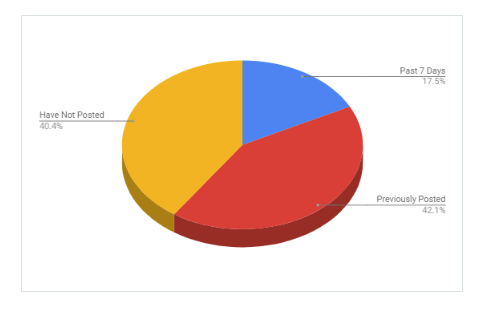
The posts don’t need to be extensive, persuasive essays to get the job done. They can even be excerpts from blog posts to lead users to the actual article on your site. Posting to GMB creates more entry poPosting images can attract a lot of search views and get people to your site as well. Images of products or finished projects will grab the attention of users to help drive more traffic to your site.ints to your website and promotes more user engagement through your business’s knowledge card.

GMB has a category to post special offers, updates, and important information about your company. Capitalize on the areas that other companies are not doing well by including GMB posts in your local content strategy.
Posting images can attract a lot of search views and get people to your site as well. Images of products or finished projects will grab the attention of users to help drive more traffic to your site.

5. Local link building
The majority of local businesses have a backlink profile that is primarily made up of directory links and profile links. An effective link building strategy for a local business is one that appears natural and above all, demonstrates evidence of relevance to your industry and city.
Build domain authority with linkable assets
The blog of every local business can be used to build authority in your industry. Publish linkable assets and insightful resources for both clients and amplifiers.
Amplifiers, as explained by Rand Fishkin, have a significant impact on the backlinks you acquire since they are the people most likely to link to your site. Creating content for amplifiers gives your site more reasons to acquire links and increase the domain authority of your site.

Linkable, shareable content makes link building much easier. You can publish guest posts, submit press releases, and reach out to authority sites in your niche to link to the inner pages of your website to increase domain authority.
Increase local ranking power with local links
Local links are considered the most powerful when it comes to localized search results as well as appearing in the Local Pack. Local links are also considered unstructured citations. Local links can come from local businesses, local newspapers, local chambers of commerce, and local event sites.
Form a local business alliance
Finding businesses within your industry is ideal for creating a local alliance and boosting your ranking ability. For example, if you’re a hot tub retailer some of your best links would come from local businesses that sell swimming pools.
As long as you don’t compete for the same products, a local business in your industry or a close vertical is the most ideal source of links.
Resource link building targeting vendors and client sites
You can improve the likelihood of obtaining local links by using your own network of resources. Companies you already do business with make for ideal link prospects.
For example, a restaurant can ask the baker who supplies their bread rolls to link from their site.
A plumber can ask his equipment suppliers and vice versa.
Ideally, you want to target business owners with whom you already have an existing relationship.
6. Review management
The reviews your business receives have the power to influence a user’s decision on whether or not to choose your company. Review management remains a top priority for local businesses to improve search visibility and maintain a good reputation.
A review strategy should include a way to get more Google reviews as well as reviews on review sites that get search visibility for related keywords. If customers are reviewing your business on sites that are niche-specific it will impact search visibility as well as promote positive ranking signals.
Identify the most important review sites in your industry
There is a major review site for every industry. It’s important to identify what review sites get a lot of traffic and reviews to position your site to receive quality prospective clients.
For example, people use Yelp or Trip Advisor to find a good restaurant in a city they’re no familiar with. People read the reviews and experiences of previous customers before making a final decision.
If you’re in the home goods business Homestars would be important sites to ask a few clients to write you a review. Here’s a 10/10 review left for Canadian Home Leisure, a hot tub retailer in Whitby, ON.
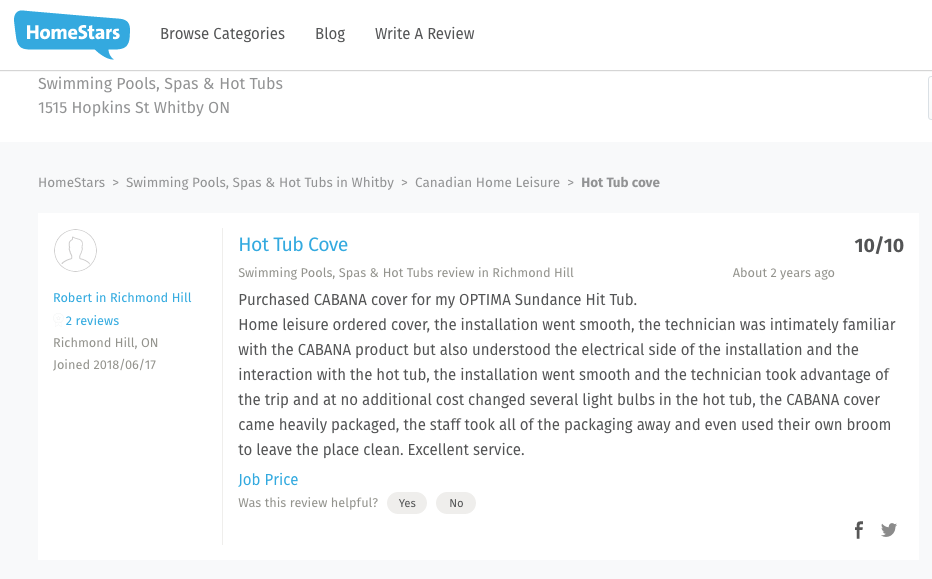
Look at the domain metrics for a site like Homestars. Not only can you get a quality backlink, but there is a ton of traffic that goes through their site.

If you’re not sure which review sites play an impact on search visibility, search for:
best + [your keyword] + [your city]
The intent of most searches that use best at the start indicates that users are looking for options, which trigger the major reviews and directory sites in your niche. Here’s a search for best suits in Toronto:
Each of these sites could be an additional way for customers to find you. Yelp looks like it’s the only review site that you can manage for free.
In fact, Yelp ranks #3 and #4. If you’re in the business of selling suits in Toronto, Yelp is definitely a site to put effort into building a detailed profile and customer reviews.
In many cases, keywords that you’re targeting will display a few directory and review sites in the search result. These are indications that those sites are not only relevant to enhance your optimization, but they will drive traffic to your site as well.

Establish your review acquisition strategy
This doesn’t need to be a major operation but you should have a plan in place that consistently gets you reviews. Avoid mass emails or anything that would look spammy such as a review station at your location. Too many reviews from the same IP could cause red flags and result in your reviews being ignored and discounted.
You can influence five-star reviews on the major review sites for your business by asking customers that you’re sure has had a good experience with your company. You can do this in a few ways:
- Train employees to ask for a review after the completion of a sale.
- Email satisfied customers thanking them for their business with links to a few different review sites.
- Hand out instructions on how to review your business along with a receipt.
Respond to as many reviews as possible
Make it a point to respond to both negative and positive reviews. Approach each response as a form of advertising for your company and a chance to showcase your customer service.
Customers will appreciate a thank you when they’ve taken the time to give you a good review.
Negative reviews demand immediate responses in order to neutralize the damage that is being done to your reputation. Show every reader how you deal with a disgruntled customer by offering to fix the problem.
People will understand when mistakes are made and offering a free service, free product or free meal can be the best form of advertising for your company.
A local SEO strategy is worth the investment
Small businesses can’t afford to miss out on the opportunities that a local SEO strategy has to offer. Following these guidelines and best practices, you can outrank authority sites (who aren’t local) and capitalize on high converting traffic.
As competition intensifies so does the need to specialize in your area of expertise. Use your location to leverage more opportunities and promote long-term growth in your industry.
Christian Carere is an SEO consultant in Toronto and the founder of Digital Ducats Inc. specializing in traffic and lead generation. He can be found on Twitter @digitalducats.
The post Guide: How to structure a local SEO strategy for your business appeared first on Search Engine Watch.
Marketing Strategies
A New Approach To Marketing
/
/Like every other aspect of business, the way we market is changing fast. We’re seeing some tried-and-true tactics — like big in-person conferences — being put on the back burner or being reimagined digitally. Entirely new marketing methods are emerging, and other established best practices are being updated for a whole new set of challenges. Being resourceful, adaptable and agile is the key to thriving and finding relevance. However, in a recent Gartner CMO study, only 52% of CMOs believed that their teams could make this shift successfully.
Taking care of your customers has always been an imperative, but now your business literally depends on it. You must be keenly aware of how your customers’ markets have shifted, if they’re struggling or how their competitive landscape has changed. Serving them and their needs with empathy is another key. Focus on giving them the experience they need, rather than the one you’re used to selling. Thinking outside the box and engaging stakeholders who aren’t in your marketing organization will help you do this. I’ve found that finance and IT can be great resources to bring a different perspective. As they say, find your tribe and tap into them whenever possible. They will bring new, fresh ideas that you may not have otherwise thought of or considered … and then use them!
Creating personalized experiences across all channels is now a mandate. Digital marketing is no longer a siloed initiative; it is an integrated part of every marketing motion and must be established as part of the marketing culture. By adopting that one strategic shift, you will increase relevancy and form connections with customers and prospects quickly and consistently.
As you’re looking at every stage of your funnel — and all your segments — adoption of AI is critical in order to deepen those connections by serving your audiences appropriately and with the right content. According to the 2020 Marketing Technology Landscape, there are now more than 8,000 martech solutions. The goal is not to use tech for the sake of tech, but to bring together, utilize, adopt and fully take advantage of the right technology that serves your needs and those of your customers and prospects.
While adoption of AI is critical, those who think martech alone is the answer must take a step back. Technology itself won’t solve everything. Simplicity and clarity in how you approach your data and your strategy is imperative regardless of what technology you have helping in the background. You must be clear and simple in your approach to data, which isn’t easy. I’m reminded of the Steve Jobs quote: “Simple can be harder than complex: You have to work hard to get your thinking clean to make it simple. But it’s worth it in the end because once you get there, you can move mountains.” Jobs was right. Those mountains will move for you if you’re willing to put in the work to move them.
I urge CMOs and marketing leaders to be simple, clear, strategic and empathetic in their thinking and approach. By doing do so, you’ll give yourself and your team the runway to make the many pivots that will be necessary to remain agile and relevant in our new landscape.
Deanna Ransom is the Head of Global Marketing and Marketing Services for Televerde, the preferred marketing, sales and customer experience partner powered by AI and technology leveraged in context by humans with a proven execution model for generating demand and accelerating sales.
Marketing Strategies
Key Insights: Amazon search-scape and factors motivating consumers
30-second summary:
- Our previous key insights clearly established that Amazon and Amazon’s Prime Day are elements of ecommerce businesses can’t miss.
- A quick look at the global Amazon search-scape - “Corona keywords” vs “Non-corona keywords”.
- What makes primary or shared decision-makers of households hit “buy now” while shopping online?
- A segmented view of Millenials, Gen Z, Gen X, and baby boomers’ ecommerce influential factors
- How word of mouth is the most powerful agent vs celebrities and influencers, and more.
Our previous key insights clearly established that Amazon and Amazon’s Prime Day are elements of ecommerce businesses can’t miss. This week we take you through what the global Amazon search-scape looks like and the prerequisites to ensure you can create more micro-moments that influence a sale.
The Amazon search-scape corona vs non-corona related searches
Remazing, a full-service agency, tracked the Top 10/Top 100 Amazon keyword searches across USA, DE, UK, FR, IT, ES markets from Feb to August using Amazon Brand Analytics. Here’s how the countries’ Amazon search-scape looks stacked up from highest to lowest “corona-related keywords”. The Corona-related search basically surrounded disinfectants, masks, gloves, soap, and toilet paper.
Consumers are turning back to normal Amazon searches with non-corona keywords rising as the months progressed.
What’s motivating consumers to buy online
With so many dynamics, getting the pulse of what makes the consumer tick has become tougher. Retail marketing technology company Bluecore and market research firm Dynata surveyed 1,005 U.S. online shoppers to understand consumer behavior and fundamental changes going into Q4 and beyond. The consumers surveyed were the primary or shared decision-makers in their households.
The most impactful channels for customer acquisition were:
- Word of mouth
- Online ads
- Influencers
- Emails
- Pop up stores
- Celebrities
- OOH (out of home) ads
In fact, word of mouth is the most effective method for existing brands as well as while consumers chose to buy from a new brand.
Contrary to popular belief, celebrities and influencers aren’t great agents for prompting people to buy your products/services.
Further segmentation of channels and their influence on different age groups
Female and male decision-makers less than 45 years old were most influenced by these channels:
- Word of mouth
- Online ads
- Emails
However, 45+ year-olds were least influenced in totality with word of mouth impacting only 59% of their buying decision, followed by online ads at 30%, and email at 40%.
Incentives consumers appreciate while buying online
A deal or no-deal moment can be the factor that hits or rewards your retail business’ bottom line on the internet. How do you create more such moments that can influence your prospective customers to hit the “buy now” button? Bluecore’s research listed the most compelling incentives that drive customers online:
- Free shipping (61%)
- Discounts (27%)
- Membership benefits (6%)
- Referral rewards (5%)
A closer look at the statistics revealed insights about which incentive appeals which age range more. While free shipping is a universally loved factor, there’s a complete contradiction between what excites baby boomers vs millennials.
To help you create your mix of the age-appropriate selling pitch, here are details on each of them. For instance, a combination of discount offers and free shipping can amplify your chances of making sales to millennials and Gen X’s counterparts in the 35 to 44 year age range.
Baby boomers’ buying decisions were most impacted by:
- Free shipping (79%)
- Discounts (18%)
- Membership benefits (3%)
Whereas, referral rewards did not excite baby boomers at all.
Gen X’s buying decisions were most impacted by:
- Free shipping (74%)
- Discounts (19%)
- Membership benefits and referral rewards (3% each)
Interestingly, Gen X’s counterparts in the 35 to 44 year age range were impacted by each of these factors which can be credited to the current world scenario and financial strains this particular age group face.
Gen Z’s buying decisions were most impacted by:
- Free shipping (52%)
- Discounts (37%)
- Membership benefits and referral rewards (5% each)
Millennial’s buying decisions were most impacted by:
- Free shipping (57%)
- Discounts (29%)
- Membership benefits (8%)
- Referral rewards (6%)
ClickZ readers’ choice for the week
Readers have continued to engage with our key insights to uncover ecommerce strategies for the holiday shopping season, the bright side of the death of third-party cookies, and how AR applications are reshaping business.
- Key Insights: Retail giants closed on Thanksgiving 2020, ecommerce set to see the biggest shopping season
- Why marketing will improve thanks to the death of third-party cookies
- Augmented reality examples: 10 industries using AR to reshape business
The post Key Insights: Amazon search-scape and factors motivating consumers appeared first on ClickZ.
Marketing Strategies
How to make your website ADA-compliant and win at SEO
30-second summary:
- The Americans with Disabilities Act (ADA) passed in 1990 does now include mobile apps and websites.
- An ADA-compliant website helps more people than those covered by ADA.
- There are many SEO benefits such as increased visibility on google image searches, and featured snippets.
- Co-founder of Ally digital media, Abhishek Shah says, “Responsive websites help with ADA compliance and further improve your website’s overall search presence.”
- The four best ways to make your website ADA-compliant with a clear outline of its ADA as well as SEO benefits.
The Americans with Disabilities Act (ADA) passed in 1990 does now include mobile apps and websites. Specifically, Title III of the ADA has taken an official stand on how websites should be accessible for disabled users. However, when you look at what’s necessary to make a website ADA-compliant, you will see that these also will help improve your site’s SEO.
Some elements such as title tags, heading structure, alt text, and responsive design are things all websites should include. By ensuring these are done properly and in an ADA-compliant way will maximize your website’s effectiveness.
How ADA accessibility prioritization benefits everyone
Ensuring your website complies with the ADA helps you serve a larger audience and gives a boost to your search engine rankings. This is because most of the necessary components of making your website ADA compliant feed directly into SEO best practices.
After all, the whole point is to make your website easier to view, understand, and navigate. What business doesn’t want all that for their website?
Four ways an ADA-compliant website helps improve your SEO
Here are 4 ADA-compliant must-haves (in no particular order) that will help improve your SEO. This list is by no means comprehensive, but it is a good place to start.
1. Title tags help screen searches and readers
Title tags are very basic SEO. They let the reader, and search engines, know what the page is about. A title tag doesn’t show up on your website. Rather, it appears on the results page of a search engine, and the tab at the top of your web browser.
SEO benefits
Title tags, while basic SEO, are very important. This tag needs to match your user’s intent. For example, when someone googles “best phone” the phrase best phone (or a variation like “best smartphone”) will appear in the title tag.
Writing a title that accurately reflects what the page is about is the best way to get found and clicked on. It’s why a title tag should be specific: “The best Android phones for 2020” is far better than “Why you will want to buy one of these phones.”
ADA benefits
For those who need screen readers to help them use a computer, a specific title tag such as the above example is much more user-friendly. So, it is vital the title tag accurately reflects the page content.
The accessibility guidelines say the title should be “The best Android phones for 2020” instead of “Why you will want to buy one of these phones.”
2. Descriptive alt text
Alt text is not the same thing as a caption. A caption is visible usually beneath an image. Whereas alt text is not visible on the front end of the site. The alt text is a written alternative to a page’s visual elements. This includes: .jpegs, .pngs, and .gifs. the alt text is a description of an image that lives in the backend of the site.
SEO benefits
Alt text lets search engines know the subject matter of an image. It also helps search engines to better understand the page. Additionally, if you want images to show up in Google, then writing descriptive alt text is a must-have.
ADA benefits
For web users with visual impairment using screen readers, descriptive alt text is read aloud. This helps a visually impaired reader get a better sense of what’s going on, on any given page.
A useful descriptive alt text might be: “woman at café with laptop drinking coffee”
A useless alt text would be: “SEO tips for freelancers | Get more clients with SEO | Writing your way to success with SEO”
3. Responsive design
Responsive design has been around since 2012/2013 in one form or another. But it means more than just your website being able to adapt to whichever screen size it finds itself on.
It’s about where your logo sits, how easy is your site to navigate, how easy is it to read, and how quickly does it load?
SEO benefits
Websites that offer good, functional user experience rank better in search results. User experience isn’t just one ranking factor but an umbrella term for quite a few. Google has said that a site that takes longer than three seconds to load on a mobile site will rank higher.
How easy content is to read (and how useful it is) is also an important ranking factor.
ADA benefits
Good responsive design puts the user first. It starts from the premise that a website needs to be easy to look at, easy to navigate, and be easy to understand.
This is why you need legible text for the visually impaired. As well as quick load times for people with slow internet. And straightforward navigation to make it easy for people to get around your website.
4. Proper heading (and subheading) structure
Headings (which show up in the code as <h1> or <h2> or <h3> etc.) define your content’s hierarchy. These headings (and subheadings) work along similar lines to when you wrote essays in school.
Proper heading structure:
- Goes in order: a h3 doesn’t go directly after a h1.
- Describes the copy beneath it.
- Follows a sequence: if your h2 is “4 ways…” then the h3s would be each of those points.
SEO benefits
When your writing is clearly structured it is easier to read, and easier to follow. It’s also easier for Google to crawl your content and understand what is the most important (starting with h1, and so on).
Good header structure can also your content appear in the featured snippets in the search engine results page (SERPs).
ADA benefits
For users who have limited reading comprehension or cognitive impairments, clear and direct headings make it easier to read. Headings and subheadings let a reader know what’s worth reading and what’s worth skipping over.
And just like a reader skips heading, so too can a screen reader. Which only reinforces the need for a strong, clear heading structure.
An example of a website that has both good SEO and is ADA compliant is Enviro Safety Products. When you review this site you will see it ticks all the boxes, and provides the user a seamless, friendly experience.
Source: Enviro Safety Products
How making your website ADA compliant will help you win at SEO
By applying all the necessary ADA compliant elements to your website, you are helping the one in four Americans with a disability use your website. Additionally, you will also greatly enhance your website’s SEO.
If you would like to know more about how making your website ADA compliant will help you win at SEO, you can throw questions in the comments section below.
Abhishek Shah is the co-founder of Ally Digital Media, a leading voice in digital media and marketing. He advocates for evidence-based marketing strategies to fuel the businesses. He can be found on Twitter @abiishek.
The post How to make your website ADA-compliant and win at SEO appeared first on Search Engine Watch.
-
 Business2 months ago
Business2 months agoBernice King, Ava DuVernay reflect on the legacy of John Lewis
-
World News2 months ago
Heavy rain threatens flood-weary Japan, Korean Peninsula
-
 Technology2 months ago
Technology2 months agoEverything New On Netflix This Weekend: July 25, 2020
-
Finance4 months ago
Will Equal Weighted Index Funds Outperform Their Benchmark Indexes?
-
Marketing Strategies9 months ago
Top 20 Workers’ Compensation Law Blogs & Websites To Follow in 2020
-
 World News8 months ago
World News8 months agoThe West Blames the Wuhan Coronavirus on China’s Love of Eating Wild Animals. The Truth Is More Complex
-
Economy11 months ago
Newsletter: Jobs, Consumers and Wages
-
 Finance9 months ago
Finance9 months ago$95 Grocery Budget + Weekly Menu Plan for 8

